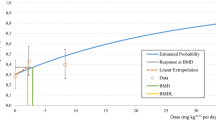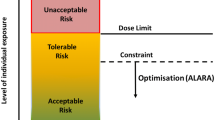Abstract
In the present study a cancer risk assessment of occupational exposure to cyclophosphamide (CP), a genotoxic carcinogenic antineoplastic agent, was carried out following two approaches based on (1) data from an animal study and (2) data on primary and secondary tumors in CP-treated patients. Data on the urinary excretion of CP in health care workers were used to estimate the uptake of CP, which ranged from 3.6 to 18 μg/day. Based on data from an animal study, cancer risks were calculated for a health care worker with a body weight of 70 kg and a working period of 40 years, 200 days a year (linear extrapolation). The lifetime risks (70 years) of urinary bladder cancer in men and leukemias in men and women were found to be nearly the same and ranged from 95 to 600 per million. Based on the patient studies, cancer risks were calculated by multiplication of the 10-year cumulative incidence per gram of CP in patients by the estimated mean total uptake in health care workers over 10 years, 200 days a year. The risk of leukemias in women over 10 years ranged from 17 to 100 per million using the secondary tumor data (linear extrapolation). Comparable results were obtained for the risk of urinary bladder tumors and leukemias in men and women when primary tumor data were used. Thus, on an annual basis, cancer risks obtained from both the animal and the patient study were nearly the same and ranged from about 1.4 to 10 per million. In The Netherlands it is proposed that, for workers, a cancer risk per compound of one extra cancer case per million a year should be striven for (“target risk”) and that no risk higher than 100 per million a year (“prohibitory risk”) should be tolerated. From the animal and the patient study it appears that the target risk is exceeded but that the risk is still below the prohibitory risk.
Similar content being viewed by others
References
American Society of Hospital Pharmacists (1990) ASHP technical assistance bulletin on handling cytotoxic and hazardous drugs. Am J Hosp Pharm 47:1033–1049
Anderson RW, Puckett WH Jr, Dana WJ, Nguyen TV, Theiss JC, Matney TS (1982) Risk of handling injectable antineoplastic agents. Am J Hosp Pharm 39:1881–1887
Arboraad (1992) Advies inzake grenswaarden voor genotoxische carcinogene stoffen. Arboraad, Zoetermeer, The Netherlands
Baker GL, Kahl LE, Zee BC, Stolzer BL, Agarwal AK, Medsger TA Jr (1987) Malignancy following treatment of rheumatoid arthritis with cyclophosphamide. Long-term case-control follow-up study. Am J Med 83:1–9
Black DJ, Livingston RB (1990) Antineoplastic drugs in 1990. A review (part 1). Drugs 39:489–501
Black DJ, Livingston RB (1990) Antineoplastic drugs in 1990. A review (part II). Drugs 39:652–673
Dumont D (1989) Risques encourus par les personnels soignants manipulant des cytostatiques. Arch Mal Prof 50:109–125
Evelo CTA, Bos RP, Peters JGP, Henderson PT (1986) Urinary cyclophosphamide assay as a method for biological monitoring of occupational exposure to cyclophosphamide. Int Arch Occup Environ Health 58:151–155
Fishbein L (1987) Perspectives on occupational exposure to antineoplastic drugs. Review. Arch Geschwulstforsch 57:219–248
Greene MH, Harris EL, Gershenson DM, Malhasian GD, Joseph Melton L, Dempo AJ, Bennet JM, Moloney WC, Boice JD (1986) Melphalan may be a more potent leukemogen than cyclophosphamide. Ann Intern Med 105:360–367
Haas JF, Kittelman B, Mehnert WH, Staneczek W, Möhner M, Kaldor JM, Day NE (1987) Risk of leukaemia in ovarian tumour and breast cancer patients following treatment by cyclophosphamide. Br J Cancer 55:213–218
Hirst M, Tse S, Mills DG, Levin L, White DF (1984) Occupational exposure to cyclophosphamide. Lancet 1:186–188
International Agency for Research on Cancer (1981) IARC monographs on the evaluation of the carcinogenic risk to humans, vol 26. Some antineoplastic and immunosuppressive agents. Lyon, France
International Agency for Research on Cancer (1987) IARC monographs on the evaluation of the carcinogenic risk to humans, supplement 7. Overall evaluations of carcinogenictiy: an updating of IARC monographs volumes 1 to 42. Lyon, France
International Agency for Research on Cancer (1990) IARC monographs on the evaluation of the carcinogenic risk to humans, vol 50. Pharmaceutical drugs. Lyon, France
Kaldor JM, Day NE, Band P, Choi NW, Clarke EA, Coleman MP, Hakama M, Koch M, Langmark F, Neal FE, Petterson F, Pompe-Kirn V, Prior P, Storm HH (1987) Second malignancies following testicular cancer, ovarian cancer and Hodgkin's disease: in international collaborative study among cancer registries. Int J Cancer 39:571–585
Kaldor JM, Day NE, Petterson F, Clarke EA, Pedersen D, Mehnert W, Bell J, Høst H, Prior P, Karjalainen S, Neal F, Koch M, Band P, Choi W, Pompe Kirn V, Arslan A, Zaré B, Belch AR, Storm H, Kittelmann B, Fraser P, Stovall M (1990) Leukemia following chemotherapy for ovarian cancer. N Engl J Med 322:1–6
Kolmodin-Hedman B, Hartvig P, Sorsa M, Falck K (1983) Occupational handling of cytostatic drugs. Arch Toxicol 54:25–33
Lijinsky W (1993) Life-span and cancer: the induction time of tumors in diverse animal species treated with nitrosodiethylamine. Carcinogenesis 14:2373–2375
Schmahl D, Habs M (1979) Carcinogenic action of low-dose cyclophosphamide given orally to Sprague-Dawley rats in a lifetime experiment. Int J Cancer 23:706–712
Schmahl D, Kaldor JM (1986) Carcinogenicity of alkylating cytostatic drugs. IARC scientific publications, nr 78. International Agency for Research on Cancer, Lyon, France
Sessink PJM, van den Broek PHH, Bos RP (1991) Urinary cyclophosphamide excretion in rats after intratracheal, dermal, oral and intravenous administration of cyclophosphamide. J Appl Toxicol 11:125–128
Sessink PJM, Anzion RBM, van den Broek PHH, Bos RP (1992) Detection of contamination with antineoplastic agents in a hospital pharmacy department. Pharm Weekbl [Sci] 14:16–22
Sessink PJM, Boer KA, Scheefhals APH, Anzion RBM, Bos RP (1992) Occupational exposure to antineoplastic agents at several departments in a hospital. Int Arch Occup Environ Health 64:105–112
Sessink PJM, de Roos JHC, Pierik FH, Anzion RBM, Bos RP (1993) Occupational exposure of animal caretakers to cyclophosphamide. J Occup Med 35:47–52
Sessink PJM, Scholtes MM, Anzion RBM, Bos RP (1993) Determination of cyclophosphamide in urine by gas chromatography-mass spectrometry. J Chromatogr 616:333–337
Sessink PJM, van de Kerkhof MCA, Anzion RBM, Noordhoek J, Bos RP (1994) Environmental contamination and assessment of exposure to antineoplastic agents by determination of cyclophosphamide in urine of exposed pharmacy technicians. Is skin absorption an important exposure route? Arch Environ Health 49:165–169
Sessink PJM, Cerná M, Rössner P, Pastorková A, Bavarová H, Franková K, Anzion RBM, Bos RP (1994) Urinary cyclophosphamide excretion and chromosomal aberrations in peripheral blood lymphocytes after occupational exposure to antineoplastic agents. Mutat Res 309:193–199
Skov T (1993) Handling antineoplastic drugs in the European Community countries. Eur J Cancer Prev 2:43–46
Skov T, Maarup B, Olsen J, Rørth M, Winthereik H, Lynge E (1992) Leukaemia and reproductive outcome among nurses handling antineoplastic drugs. Br J Ind Med 49:855–861
Sladek NE (1988) Metabolism of oxazaphosphorines. Pharmacol Ther 37:301–355
Sorsa M, Hemminki K, Vainio H (1985) Occupational exposure to nticancer drugs-potential and real hazards. Mutat Res 154:135–149
Author information
Authors and Affiliations
Rights and permissions
About this article
Cite this article
Sessink, P.J.M., Kroese, E.D., van Kranen, H.J. et al. Cancer risk assessment for health care workers occupationally exposed to cyclophosphamide. Int. Arch Occup Environ Heath 67, 317–323 (1995). https://doi.org/10.1007/BF00385647
Received:
Accepted:
Issue Date:
DOI: https://doi.org/10.1007/BF00385647




